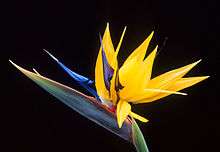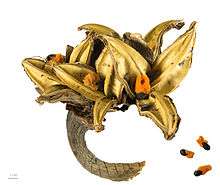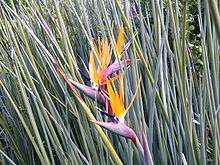Strelitzia
Strelitzia /strɛˈlɪtsiə/[1] is a genus of five species of perennial plants, native to South Africa. It belongs to the plant family Strelitziaceae.[2] The genus is named after the duchy of Mecklenburg-Strelitz, birthplace of Queen Charlotte of the United Kingdom. A common name of the genus is bird of paradise flower / plant, because of a resemblance of its flowers to birds-of-paradise. In South Africa it is commonly known as a crane flower and is featured on the reverse of the 50 cent coin. It is the floral emblem of the City of Los Angeles; two of the species, Strelitzia nicolai and Strelitzia reginae, are frequently grown as house plants.[3]
| Strelitzia | |
|---|---|
 | |
| Scientific classification | |
| Kingdom: | Plantae |
| Clade: | Tracheophytes |
| Clade: | Angiosperms |
| Clade: | Monocots |
| Clade: | Commelinids |
| Order: | Zingiberales |
| Family: | Strelitziaceae |
| Genus: | Strelitzia Aiton |
| Type species | |
| Strelitzia reginae | |
| Species | |

Description
The species S. nicolai is the largest in the genus, reaching 10 m tall, with stately white and blue flowers;[4] the other species typically reach 2 to 3.5 m tall, except S. caudata which is a tree of a typically smaller size than S. nicolai. The leaves are large, 30–200 cm long and 10–80 cm broad, similar to a banana leaf in appearance but with a longer petiole, and arranged strictly in two ranks to form a fan-like crown of evergreen foliage. The flowers are produced in a horizontal inflorescence emerging from a stout spathe.
Biology and propagation
They are pollinated by sunbirds, which use the spathe as a perch when visiting the flowers. The weight of the bird when standing on the spathe opens it to release the pollen onto the bird's feet, which is then deposited on the next flower it visits. Strelitzia lack natural insect pollinators; in areas without sunbirds, plants in this genus generally need hand pollination in order to successfully set seed.[5]
Species and hybrids
Five species are recognised, although one—Strelitzia juncea—has been shown to be genetically nested within another, Strelitzia reginae. It is possibly a mutation that is in the process of speciating.[6]
| Image | Scientific name | Common Name | Distribution |
|---|---|---|---|
 | Strelitzia alba (syn. S. augusta) | White bird of paradise | Garden Route along the southernmost coastal regions of the Eastern and Western Cape in South Africa. |
| Strelitzia caudata | Mountain strelitzia | Chimanimani Mountains of Zimbabwe south to Mozambique, the Northern Provinces of South Africa and Swaziland | |
| Strelitzia nicolai | White bird of paradise or giant bird of paradise; wild banana; blue-and-white strelitzia[4] | Mozambique, Botswana, Zimbabwe,and Eastern South Africa from the Great Fish River northwards to Richards Bay | |
.jpg) | Strelitzia reginae (syn. S. parvifolia) | Strelitzia, bird of paradise, or crane lily | Madeira, South Africa (the Cape Provinces and KwaZulu-Natal) |
 | Strelitzia juncea (Ker Gawl.) ) | African desert banana[7] | South Africa near Uitenhage, Patensie and just north of Port Elizabeth |
- Strelitzia × kewensis (hybrid between S. reginae and S. augusta)
Allergenic potential
Plants in the genus Strelitzia produce no windborne pollen, and have an OPALS allergy scale rating of 1 (considered "allergy-fighting").[5]
References
- Sunset Western Garden Book, 1995:606–607, Sunset Books
- "Tropical Flower Guide". Retrieved 30 November 2012.
- "Our House Plants - Bird of Paradise". Retrieved 18 July 2014.
- Eliovson, Sima (1981). Shrubs, trees, and climbers. Macmillan South Africa. ISBN 0-86954-011-4. Retrieved 2009-09-12.
- Ogren, Thomas (2015). The Allergy-Fighting Garden. Berkeley, CA: Ten Speed Press. p. 200. ISBN 978-1-60774-491-7.
- Cron, Glynis V.; Pirone, Cary; Bartlett, Madelaine; Kress, W. John; Specht, Chelsea (2012). "Phylogenetic Relationships and Evolution in the Strelitziaceae (Zingiberales)". Systematic Botany. 37 (3): 606–619. doi:10.1600/036364412X648562.
- Strelitzia juncae, Royal Botanic Gardens, Kew
External links
